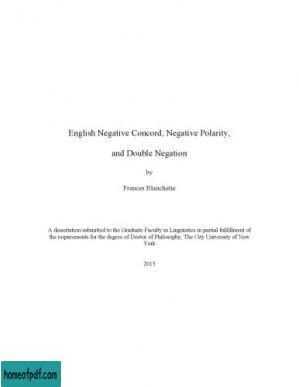English Negative Concord, Negative Polarity, and Double Negation 电子书下载
In Negative Concord (NC) sentences, single negative meanings are expressed by two or more negative words. English speakers that use NC also employ Double Negation (DN), where two negatives yield a logical affirmative. The same speakers also use Negative Polarity Item (NPI) constructions, where words like anything and anybody depend on a preceding negation (e.g. `I didn`t eat anything` vs. `I ate anything`). This dissertation accounts for the distributions of NC, NPI, and DN constructions in English.
I apply the theory of NPIs in Postal (2005) and Collins and Postal (2014) to NC and DN. These authors argue that some NPIs have the form [NEG SOME X], with a single NEG, while others have two: [[NEG [NEG SOME]] X]. I propose that negative constituents have a structure identical to Collins and Postal`s (2014) unary NEG NPIs. Like NPI constructions, NC with a negative marker (-n`t/not) and a negative object involves syntactic NEG raising from the negative constituent. I further propose that the locus of variation between NC and NPI constructions lies at the level of morphophonological spell out. NPI constructions involve deletion of lower occurrences of a single NEG, but NC does not. Using data from the Audio-Aligned and Parsed Corpus of Appalachian English (Tortora et al., In Progress), I show that all predictions concerning the distribution of NC, DN, and NPI constructions across clause boundaries are borne out.
Two types of NC with negative subjects are also analyzed. NC declaratives like `didn`t nobody eat` and `nobody didn`t eat` are derived via NEG raising from a negative constituent. In these cases, NEG raising is followed by remnant raising of the negative constituent. To explain restrictions on subject type in inverted structures (`didn`t nobody eat`), I defend a condition stating that the subject must always be negative, despite the fact that it is not always morphologically negative. Differences in usage and interpretation of negative object and negative subject constructions are derived by appeal to a remnant raising condition. The results of a gradient acceptability study support the hypothesized grammatical distinction between Subject and Object NC.
尊敬的读者:
欢迎您访问我们的网站。本站的初衷是为大家提供一个共享学习资料、交换知识的平台。每位用户都可以将文件上传至网盘并分享。
然而,随着用户上传的资料增多,我们发现部分不宜或版权问题的书籍被分享到了本站。
为此,我们已经关闭了分享入口,并进行了多次书籍审查,但仍有部分内容未能彻底审查到位。
在此,我们恳请广大读者与我们共同监督,如发现任何不宜内容,请 点击此处 进行举报,我们会第一时间处理并下架相关内容。
希望我们能共建一个文明社区!感谢您的理解与支持!
猜你喜欢
- 《聪明人的心理学》[美]大卫﹒麦克雷尼全译修订版 电子书下载
- 《明一居士》 电子书下载
- 《投资核心资产:在股市长牛中实现超额收益》王德伦等白金版 电子书下载
- 《价值评估:公司价值的衡量与管理》蒂姆·科勒中文版 电子书下载
- BPMN Modeling and Reference Guide - Stephen A. White 电子书下载
- 《CEO说:像企业家一样思考》 [美] 拉姆·查兰文字版 电子书下载
- 《新东方:十天搞定考研词汇》 电子书下载
- 《稻盛和夫的人生哲学》 [日]北康利文字版 电子书下载
- 《曾国藩(全3册)》唐浩明珍藏版 电子书下载
- Mobile JavaScript Application Development - Adrian Kosmaczewski 电子书下载
- 《ERP沙盘模拟经营实训教程》李玉良文字版 电子书下载
- 《金枝(套装共2册)》[英] 詹姆斯·乔治·弗雷泽 电子书下载












